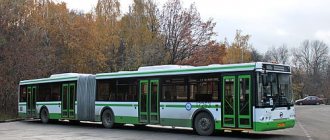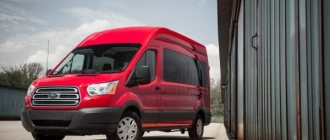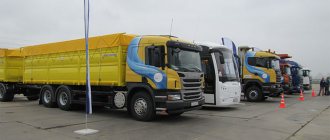Details Category: Electric buses Published: 08/29/2016
- Introduction
- Specifications
- Main nodes
- Presentation of the electric bus
Much has been written about the advantages of electric transport, including passenger transport. Residents of megacities are already suffocating from car exhaust fumes, the number of which is only growing over the years. In developed countries, they have long been thinking about an alternative to automobile internal combustion engines, and information about electric vehicles for various purposes is increasingly appearing in the media.
The interest of the public and specialists in the large-capacity KamAZ 6282 electric bus is understandable, especially since it is designed to transport groups of passengers with limited mobility. The low-floor body version, low noise level in the cabin, operational efficiency and environmental friendliness allow us to conclude that the innovative electric bus is promising. It recently successfully completed testing and was transferred to the Mostransavto motor transport company for operation in various climatic conditions with passenger traffic of varying intensity. Testing on city routes is planned to be carried out within two months.
Specifications
Dimensions
- Length - 12350
- Width - 2550
- Height - 2770
- Wheelbase - 6170
- Gross weight - 18800 kg
Main characteristics
- Maximum speed - 75 km/h
- Number of seats - 25
- Maximum capacity - 85 people
- Operating temperature range - -30...+45 degrees
Modifications
Experienced LiAZ-6274
Experienced electric buses are a type with ONC charging (night slow charging in the park). The production model will be produced in a version with OC charging (ultra-fast charging from a charging station).
6274
Built on the basis of a bus modification LiAZ-5292.22
in June 2012. Equipped with lithium-ion batteries manufactured by . The estimated maximum range is 200 km.[1][2] This electric bus was transferred to FATP for testing, and it was assigned the number 08106. Unfortunately, this electric bus very quickly failed, tests of the electric bus with passengers never took place and the electric bus returned to the factory. Unsuccessful testing of the model called into question the launch of LiAZ-6274 electric buses into mass production.
6274.00 (ONC)
Rebuilt from a prototype bus modification LiAZ-5292.30
. An improved version of the first electric bus model with lithium titanate batteries along the entire roof plane. Tested at the branch from December 2020 to October 2020. This electric bus successfully passed double tests, both during a two-month run-in and with passengers on route No. M2, and then returned to the factory, and from there it went to permanent work in Tyumen. Serial production of electric buses based on the LiAZ-5292.22 bus was supposed to begin in December 2020[3], but the plant later abandoned these plans.
6274.00 (OC)
In February 2020, a second copy was built based on the LiAZ-5292.65-77
. It is distinguished by the installation of ultra-fast charging and a smaller number of batteries placed on the roof. The initial prototype used the same charging method as the ONC electric bus (pistol charging). By removing the engine shaft, as well as placing a full rear window and additional seats, the electric bus received a hump on the roof, into which other electrical equipment was moved. This version of the electric bus successfully passed the tender, but during trial operation without passengers, the first version of the electric bus with pistol charging failed the tests. In September 2020, serial production of an electric bus with pantograph charging began. By the end of 2018, it is planned to supply 100 electric buses to the North-Eastern branches and to transfer part of the trolleybus and bus routes identified in the competition.
[edit] Comparison with other types of electric buses
An electric bus with dynamic charging is a qualitative reassessment of the concept of an autonomous trolleybus[8]. In 2020, in some sources dedicated to electric public transport, the definition of “electric bus with dynamic charging” appeared [3][9][10][11][12].
| Electric bus with charging at the depot | Electric bus with charging at stops | Electric bus with dynamic charging (trolleybus with increased autonomous travel) | Trolleybus (with minimal autonomous travel) | |
| Technology name | ONC (Overnight charging) | OC (Opportunity charging) | IMC (In-motion charging) | |
| Energy storage method | Overnight slow charging | Ultra-fast charging along the route during part of the stops | Dynamic charging when moving along a section of overhead contact line | — |
| Autonomous range | from 150 km | 20 – 70 km | 5 – 70 km | up to 2 km |
| Charge Features | Requires concentration of increased energy capacity in the park; Electricity consumption peaks at night, when it is cheaper. During the day, the electric bus is not tied to the infrastructure and can replace the bus | Requires charging currents over 300 A; at places of application it creates an intermittent load on the electrical network, which negatively affects the energy system | Creates a distributed load on the city power grid throughout the day; Thanks to the contact networks that connect the substations, it is possible to perform various switchings, ensuring a stable energy supply, however, this type of charging can only be used in cities with trolleybus infrastructure, and at least 30% of the vehicle route must pass under the contact network, which reduces the flexibility of using the machines . In addition, there is a risk of the contact wire being burned by the battery charging current when the machine is moving at low speed or when stopping | |
| Energy infrastructure requirements | Requires a general revision of the city’s energy system, connecting powerful power lines to parks | It is required to organize a network of charging stations near powerful energy sources (district substations with a voltage of at least 35 kV). It is also possible to use the energy infrastructure of the tram (near traction substations) and the metro (when the final stops are located near the stations) | Existing infrastructure is used; when carrying out routes to new areas, the contact network may not be developed | Existing infrastructure is used; When carrying out routes to new areas, capital investments in the contact network are required |
| Easy to charge | 4 – 10 hours (in the park) | 5 - 25 minutes (at the bus stop)[ source? ] | Absent | |
| Batteries | It is distinguished by a large mass of batteries, due to which there is less space for passengers in the cabins; in low-floor implementations, heavy batteries are placed on the roof, which reduces rollover resistance | Moderate size batteries | Small batteries | |
| Battery life | Deep discharge levels have a negative impact on batteries | High charging current and deep discharge level negatively affect batteries, however, if you replace batteries with supercapacitors, the problem can be easily resolved [13] | colspan=»2″| Battery operation in gentle mode | |
| Heating | For heating and heating it is necessary to use an auxiliary diesel generator | Electric heating and interior heating when passing most of the route under the contact network does not require the use of auxiliary diesel generators | ||
| Route network flexibility | Flexible, like buses, except for a more rigid connection to the fleet | Linking routes to charging stations (points with high passenger traffic) | Linking to sections of the contact network (main streets with increased passenger traffic) | Full connection to the contact network |
An electric bus with dynamic charging is also the successor to another type of trolleybus, the duobus, but the latter is seriously inferior to it in terms of environmental friendliness. The source of autonomous movement of a duobus is combustible fuel (gasoline or diesel), while for a dynamic electric bus it is an electrochemical energy carrier. At the same time, a dynamic electric bus has the ability to recover energy back into the traction battery, while a duobus does not have this ability due to the use of a generator set for combustible fuel.
Specifications
| Specifications | |
| Wheel formula | 4x2 |
| Body | Carrier, carriage layout |
| Number of doors | 3 |
| Door width, mm | 2x 1325 + 1x 1225 |
| Body life, years | 10–12 |
| Total number of seats | 105–112 |
| Number of seats | 25 |
| Turning radius, m | 11,5 |
| Maximum speed, km/h | 70 |
| Electricity consumption, kW/h | 23/100 km |
| Brake system | Pneumatic, dual-circuit, with ABS |
| Length, mm | 11 990 |
| Width, mm | 2 500 |
| Height, mm | 3,140 (ONC) / 3,300 (OC) |
| Base, mm | 5 960 |
| Total weight, kg | 20 000 |
| Cabin ceiling height | 2200…2280 |
| Ventilation | Natural through the windows; forced, air conditioning system (optional) |
| Heating system | Radiator type |
| Rear axle | Portal |
| Equipped with electric motors | ZF AVE13 |
[edit] Development of IMC technology in Russia
Autonomous versions of the most common trolleybus ZiU-682 began to appear in the 1980s. This was primarily intended for export options. For example, a batch of ZiU-682V1 for the city of Cordoba were equipped with 9NKLB-70 alkaline batteries located under the rear platform. They provided an autonomous range of about a kilometer at a speed of 5 km/h. This made it possible to drive around the scene of an accident, overcome broken contact lines, and maneuver in the park[31].
Later, various trolleybuses were equipped with autonomous operation, but their range did not exceed a couple of kilometers.
The first Russian trolleybus with truly increased autonomous travel was the ST-6217M, created jointly with the enterprises Liotech LLC, Sibeltransservice OJSC, Siberian Trolleybus LLC, NPF Irbis LLC, NPF Ars-Term LLC “”, Research Institute of Solid State Chemistry of the Siberian Branch of the Russian Academy of Sciences, Novosibirsk State Technical University, with the participation of transport enterprises of the Novosibirsk City Hall and its leaders. The prototypes traveled autonomously for up to 60 kilometers at the full weight of the trolleybus (that is, as if it were completely filled with passengers). The battery consists of 144 lithium-ion batteries, battery capacity is 240 Ah, battery weight is 1060 kg, which is slightly more than 5% of the total weight of the trolleybus. The trolleybus was put into operation in Novosibirsk on route No. 401, the length of which in single-track terms is 45.56 kilometers, of which 17 kilometers are without a contact network [32].
Subsequently, Sibeltransservice OJSC purchased Trolza-5265 Megapolis bodies and based on them produced low-floor TrolZa-ST-5265A. In 2013, they entered the roads of Novosibirsk and then Tula.
JSC "Trolza" (formerly the Uritsky Plant), using its experience in creating trolleybuses with autonomous running, in 2012 also began developing trolleybuses equipped with lithium batteries with increased autonomous running, which later, for marketing reasons, began to be positioned as electric buses with dynamic charging[33] . After testing in various regions of Russia (Vladimir Region, Crimea, Stavropol Territory, Krasnodar Territory, Bashkiria, Adygea, Perm Territory), the electric bus was put into mass production and began to be delivered to Russian cities[34] (Tula, Nalchik, St. Petersburg, for needs of State Transport Leasing Company), as well as abroad (Argentina, the cities of Rosario and Cordoba).
In 2016-2017, presentations of electric buses with dynamic charging "Trolza" took place in Kovrov, Sterlitamak, Maikop, Krasnodar, Yekaterinburg[35], Stavropol, Makhachkala, Volgograd[36], Perm, Cheboksary[37], as well as in the city of Vidnoye[ 38] Moscow region and St. Petersburg.
On September 22, 2020, an electric bus with dynamic charging was presented as part of a meeting of the Presidium of the State Council of Russia dedicated to the development of public transport.[39]
Technical characteristics of the electric bus with dynamic charging Trolza:
| Name | Characteristics |
| dimensions | 12660/2550/3470 |
| Maximum speed, km/h | 60 |
| Passenger capacity | 80-100 people |
| Number of seats | 29-34 |
| Floor level, mm | 360 |
| Maximum climbability, % | 15 |
| Autonomous range | up to 35 km |
| Life time | 10 years |
[edit] Electric buses with dynamic charging in St. Petersburg
In 2020, a contract was signed for the supply of more than 100 electric buses with dynamic charging to St. Petersburg. The contract amount was more than 2 billion rubles[40]. Equipment suppliers are Trolza CJSC and Belkommunmash OJSC.
Dynamic charging electric bus Seattle, USA
From December 2020 to February 2020, 3 new routes with electric buses with dynamic charging based on existing trolleybus routes were opened in St. Petersburg[41].
- On December 12, 2020, in the Primorsky district, electric buses went on route No. 23 (Shavrova Street - Bogatyrsky Avenue).
- On December 27, 2020, in the Krasnoselsky district, route No. 41 was extended, the route of which connected the Kirovsky Zavod metro station with the Baltic Pearl microdistrict.
- On February 12, 2020, electric buses entered route No. 2 in the Primorsky district and connected the Komendantsky Prospekt metro station with the Yubileiny quarter.
The first electric bus route was inaugurated with the participation of the Governor of St. Petersburg Georgy Poltavchenko[42].
Dynamic charging electric bus Esslingen, Germany
A significant portion of new routes are covered by electric buses autonomously. Thus, St. Petersburg State Unitary Enterprise "Gorelektrotrans" managed to connect new areas with an environmentally friendly mode of transport without building infrastructure.
The first months of operation of electric buses with dynamic charging in St. Petersburg were highly appreciated by the St. Petersburg State Unitary Enterprise "Gorelektrotrans". Thus, within a month of operation after the launch of electric buses with dynamic charging, passenger traffic on route No. 23 increased almost 10 times[43].
The opening of new routes is steps towards the implementation of the program for the development of public transport in St. Petersburg, adopted in 2015.
On January 26, 2020 in Brussels, the director of St. Petersburg State Unitary Enterprise “Gorelektrotrans” Vasily Ostryakov, at a meeting of the Trolleybus Committee of the International Union of Public Transport (UIPT), presented a report on the launch in St. Petersburg of new routes served by electric buses with dynamic charging[44].
[edit] Electric buses with dynamic charging in Barnaul
In Barnaul, two ST-6217M vehicles manufactured by Sibirsky Trolleybus (Novosibirsk) are in trial operation, the routes of which run to new areas not covered by the trolleybus contact network. It is planned to purchase another 10 to 30 vehicles, some of which will operate on the Barnaul-Novoaltaysk route. However, operation also showed serious problems: contact wire burns when charging batteries from the contact network, poor heating in winter when driving autonomously.
[edit] History of deliveries of electric buses with dynamic charging Trolza
year 2013
— Podolsk (1 unit).
year 2014
— Tula, Nalchik, Togliatti, Krasnodar, Sevastopol (29 units).
2015
— Cordoba (Argentina), Maykop (3 units).
2016
— Rosario (Argentina) (2 units).
2017
— St. Petersburg, Rosario, for the State Transport Leasing Company (157 units).
2018
— St. Petersburg (deliveries continue).
2019
— Krasnoyarsk (1 unit).






